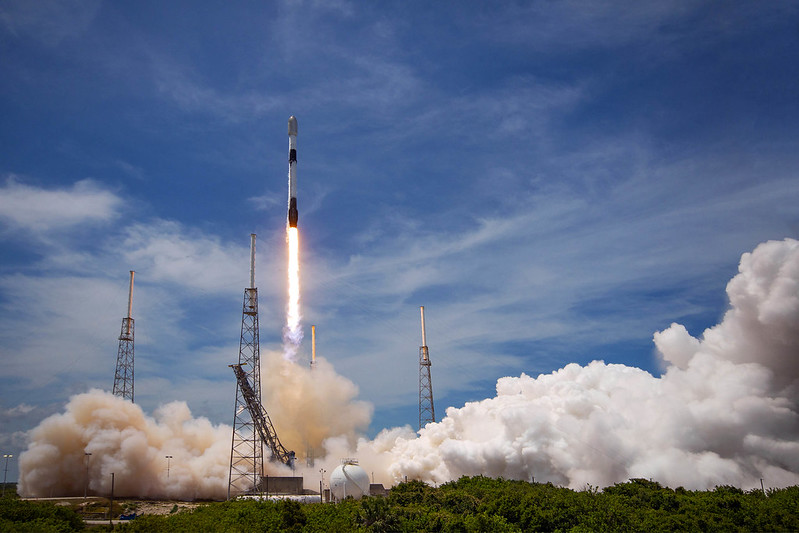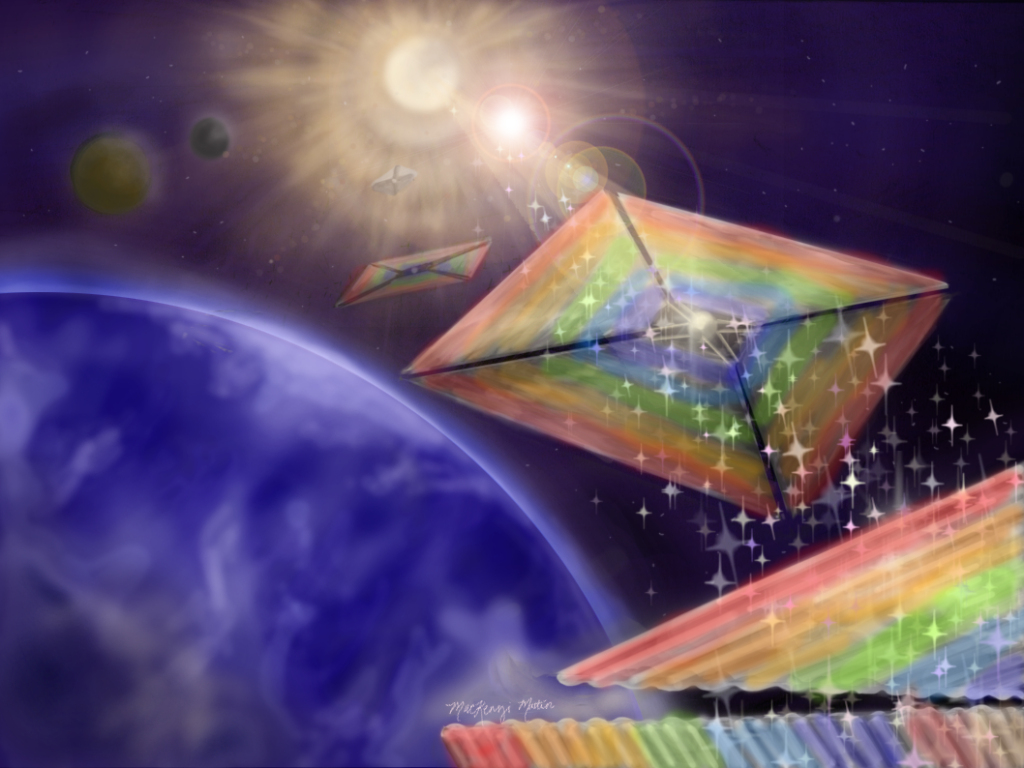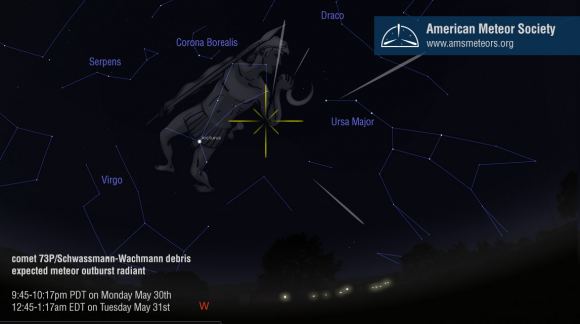Due to the gravitational pull of Jupiter on the fragments and dust of comet 73P/Schwassmann-Wachmann, Earth’s orbit may be moving through a dense portion of the comet’s trail on May 31. This alignment could result in an unusually spectacular meteor outburst, and we’ll interview astronomer Pierre Martin about this possible event. Plus, a SpaceX launch that wasn’t Starlink, a new solar sail, and JWST.
Podcast
Show Notes
SpaceX launches Transporter-5 rideshare
- Transporter-5 mission page (SpaceX)
- Spaceflight, Inc. press release
- Who’s Onboard Transporter 5? (Spaceflight, Inc.)
- Launch video
Transporter-5 carried two NASA missions
- NASA Goddard press release
NASA awards JHUAPL grant to design solar sail
- NASA press release
Maths of early universe also work for meteorology
- University of Copenhagen press release
- “The power spectrum of climate change,” Albert Sneppen, 2022 May 5, The European Physical Journal Plus
JWST gears up for science
Possible meteor outburst next week
- Possible Meteor Outburst on May 30/31? (American Meteor Society)
- CBET 5125: tau Her Meteors 2022 (SETI Institute)
- VIDEO: Tau Herculids: an outburst in May 2022? – Pierre Martin (RASC)
Transcript
Breaking news isn’t something we get very often, but today, we have exciting sorta breaking news that next Monday night’s meteor shower could be the storm of the century. Beth Johnson will be getting us the details in an interview with Pierre Martin.
Those meteors are the tau Herculids, and they promise to be amazing if you have clear skies. If you have clouds, well, another story may help explain your weird weather and global temperature variations.
We also have new space technology, from laser communications to solar sails.
And hey, SpaceX launched something that wasn’t a Starlink!
All of this and more, right here on the Daily Space.
I am your host Dr. Pamela Gay.
And I am your host Erik Madaus.
And we’re here to put science in your brain.

On May 25 at 18:35 UTC, a SpaceX Falcon 9 launched from SLC-40 at the Cape Canaveral Space Force Station. Onboard were 59 spacecraft in the Transporter-5 mission, the latest in SpaceX’s dedicated smallsat rideshare missions.
After the first stage separation, the stage performed a boost back maneuver and landed at Landing Zone 1, also at Cape Canaveral. Not every mission allows a first stage boost back, particularly during the daytime, so this event was a rare sight. The booster, 1061, was on its eighth flight.
We don’t have nearly enough time to talk about all of the payloads on this flight, but there was one that caught my attention.
Spaceflight, Inc. has a new version of their Sherpa vehicle called the Sherpa-AC. This version improves on the existing spacecraft by adding attitude control and solar panels, allowing the spacecraft to stay operational with hosted payloads for up to 8 years until it decays from orbit due to atmospheric drag. The Sherpa AC does not have propulsion; however, it can also tell the hosted payloads their orientation and point them in the desired directions, something the previous version of the Sherpa was not capable of.
Another new thing is the ability for “two-way RF communication”, permitting ground control to send new commands in addition to receiving data from the payloads. The Sherpa AC on this flight has five payloads; three of them will be deployed.
I said we didn’t have enough time to talk about the payloads on Transporter-5. I was wrong. Here’s more science!

One of the innovations of small satellites is being able to build a spacecraft and put a payload on it instead of having to design a spacecraft from scratch depending on the unique needs of the payload. NASA’s Pathfinder Technology Demonstrator (PTD) program uses a common spacecraft design with different possible payloads to reduce costs and the time to produce and to increase efficiency. This allows more cool things to fly into space.
The third Pathfinder Technology Demonstrator spacecraft is demonstrating a laser communications payload called TBIRD. Like the spacecraft, TBIRD also uses off-the-shelf components instead of expensive space-rated parts.
One of the requirements of laser communications is that the spacecraft has very accurate attitude control so that it can transmit information to a small receiving station – basically a telescope on a tracking mount – while moving in space at 8 kilometers per second. Unlike radio comms, laser beams are smaller, but the advantage is a much higher data rate, so future spacecraft can send back more data faster. This mission only has one of those special ground stations, located in Table Mountain, California, near San Jose.
PTD-3 launched on Transporter-5 and has a planned mission duration of six months.
Another NASA mission on Transporter-5 is the CubeSat Proximity Operations Demonstration, where two CubeSats will practice rendezvous and docking. This has never been done before with spacecraft of this small size. We’re excited to find out how this one turns out.

Another emerging space technology is solar sails — specifically, diffractive solar sails.
Solar sails, in general, work due to the force of photons – which do have mass equivalent through energy – hitting the sails, reflecting off, and causing an equal/opposite reaction. This process produces a very, very small but constant thrust, allowing spacecraft to build up speed gradually over months and years. This technology could get spacecraft to orbits not possible with chemical propulsion, such as orbiting the Sun’s poles.
Diffractive solar sails add small patches of diffraction grating to the sail, using them to make the sail lighter and produce even more thrust by focusing light in the grates. Diffraction is also why you may get soft images with a camera if you step down the lens aperture a lot. The small diffraction patches also let the spacecraft steer more easily by allowing the spacecraft to move further away from the Sun and still produce thrust.
A team from the Johns Hopkins Applied Physics Laboratory was recently given a $2 million phase three grant from the NASA Innovative Advanced Concepts (NIAC) program to bring these diffractive sails to a flight demonstration in a few years. The team is led by Amber Dubill, who was recently a guest on the Weekly Space Hangout, our sister podcast. We’ll link to her interview in our show notes at DailySpace.org.

Here in Illinois, our weather has been even more wild than normal this past year. From Amazon warehouse eating tornadoes in December to temperatures that fluctuate 30 degrees per day in randomized directions, we have hit a point where… I don’t even have words for it other than, “I do not like this.”
Now, research published in The European Physical Journal Plus by Albert Sneppen uses spherical harmonics to show how global temperature increases can increase local temperature variations.
Put another way, an astronomy grad student took the maths we use to describe temperature variations in the early universe and used that math to define how global temperature increases affect regions as small as 50 kilometers. According to Sneppen: The instability and volatility of the weather has generally grown since the industrial revolution, but has especially gained momentum over the last 40 years. Together with several other theoretical and observational studies, this model indicates that the weather will become even more unstable in the coming decades.
We’d known experimentally that the world’s weather was showing more extremes. From ice storms in England to 150-degree days in India, we can’t not see the extremes, but this is the first time someone could explain it. And it was an astronomer – a student – who realized that the same physics that moderated the temperatures in our early universe are at play in our atmosphere.
Science is the same everywhere, and next time you are tempted to tell a researcher to stay in their lane, I want you to remember this story and remember that physics doesn’t care if you’re studying the Earth or the early universe, and sometimes it takes fresh eyes to realize how to take lessons learned in one context and apply them elsewhere.

Before we switch over to today’s big news – the upcoming tau Herculids meteor shower – we want to give you a quick update on the JWST. This origami infrared telescope is gearing up for science. According to a NASA update, the telescope has used an asteroid to make sure the telescope could track solar system objects, and now it is gearing up to include solar system targets in its first test science.
With targets ranging from Jupiter’s moon Europa to the distant planet Uranus, JWST will be able to use its large instruments to measure the chemistry of these objects in ways the standard small spacecraft just can’t. Hopefully, before the summer is out, we’ll see some of the science.
Before the interview, here is a little background information on the tau Herculids.
The meteor shower is what’s left of Comet 79P/SW3, which disintegrated in 1995. SW3 was discovered in 1930 by two German astronomers while they were looking for asteroids. The disintegration made the comet much brighter than it was previously – so bright that it was visible with the unaided eye for a short period of time.

Although the shower is called the tau Herculids, the radiant this year will actually be in Böotes, near the globular cluster M3. The wandering of the radiant is caused by the gravitational pull of Jupiter, which has changed the orbit of the remnants of SW3. Look to the east-southeast for Böotes, which reminds me of Gossamer from Looney Tunes. The radiant is in a direct line between the star Thiba in Böotes, the left shoulder, and chi Herculis, in the constellation Hercules. Both of these stars are bright enough to see with the unaided eye.
The shower will peak in a half-hour window on May 31 starting at 05:04 UTC, or four minutes after midnight Central Time, in the middle of the night from May 30 to the 31st.
And now, Beth will be joining us to chat with astronomer Pierre Martin about the tau Heruclids.
What’s Up/Interview
Instead of our usual What’s Up segment, today we have an interview regarding an event you can watch with the unaided eye.
Joining me now is Pierre Martin, an astronomer whose passion is observing major and minor meteor showers. Earlier this month, he spoke to the Royal Astronomical Society of Canada about this possible meteor storm during the upcoming tau Herculids shower, and we’re thrilled to have him here today.
Welcome, Pierre, and thank you for joining us.
[Transcript unavailable]
Once again, Pierre, thank you for being here today. Fingers crossed that this turns out to be a fantastic event. We could definitely use awe and wonder in our lives right now.
This has been the Daily Space.
To all of you watching, this conversation ran longer than we can air here on NowMedia. You can catch the interview in its entirety on our website, DailySpace.org.
While you’re there, check out our show notes to find more information on all our stories, including images. As always, we’re here thanks to the donations of people like you. If you like our content, please consider joining our Patreon at Patreon.com/CosmoQuestX.
Credits
Written by Pamela Gay, Beth Johnson, Erik Madaus, and Gordon Dewis
Hosted by Pamela Gay, Beth Johnson, and Erik Madaus
Audio and Video Editing by Ally Pelphrey
Content Editing by Beth Johnson
Intro and Outro music by Kevin MacLeod, https://incompetech.com/music/


 We record most shows live, on Twitch. Follow us today to get alerts when we go live.
We record most shows live, on Twitch. Follow us today to get alerts when we go live.